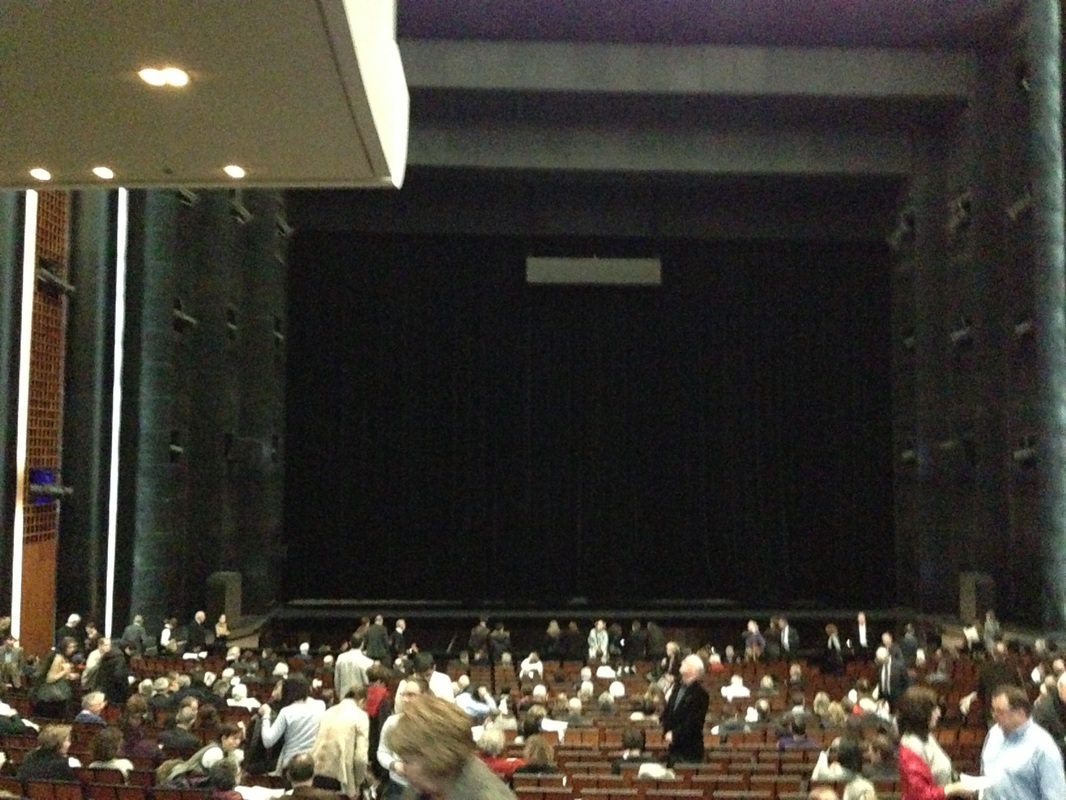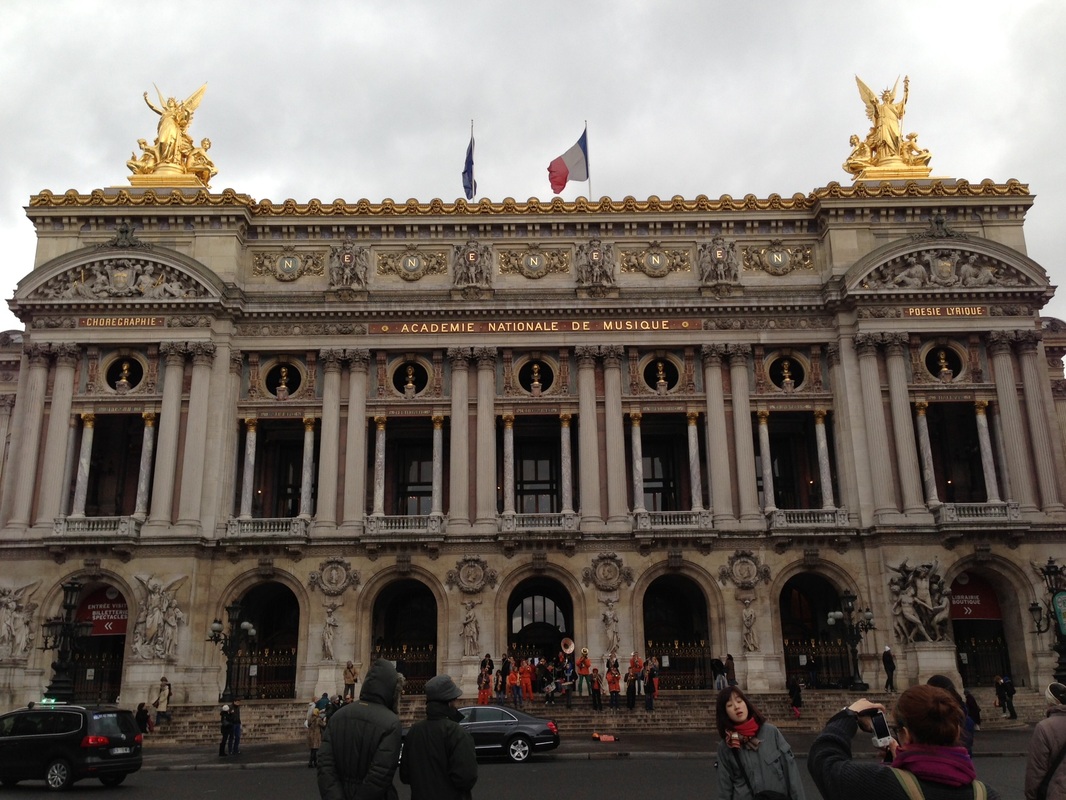Bastille Days
G Donizetti: L’Elisir d’Amore; Berlioz: Les Troyens, Opéra Bastille, Paris, 8,9 November 2006.
The opportunity of meeting Swedish Glyndebourne companions in Paris combined with the revival of a production of Les Troyens at L’Opéra Bastille was too good to miss. An added delight was a performance of L’Elisir d’Amore the previous evening. The result was an action packed five days, thanks to Eurostar. Events included a book launch party at the Cercle Suedois, the Balenciaga exhibition at the newly reopened Musée des Arts Decortifs, an exhibition of some sixty lesser-known portraits by Titian and contemporaries, an expert guided tour of the Marais district, a concert of music by Marin Marais and a tented brocante of antiques in Place Bastille. The exhibition of Balenciaga frocks was fascinating. The discarded form-fitting carapaces carried an erotic charge strangely complementary to the sculptures of Rodin. Titian, my hero, alas and surprisingly, did not come off well in comparison with the Holbeins on view in London. The viol music was too po-faced to do justice to this great composer and marred by terrible acoustics; the brocante was impressive but dear. The stimulation of these daytime activities formed a perfect background for two great operas in the evening.
L’Elisir d’Amore I first saw in Oxford Playhouse in 1976 in an imaginative production directed by Graham Vick for Scottish Opera Go Round in which the cast emerged from and departed in a large wicker hamper, which was wheeled onto the stage. The production at the Bastille was revelatory. The director Laurent Pelly reminded me of Peter Stein in his total dedication to interpreting the opera as written. It gave a softer, less sardonic view of Donizzetti than usual. Another comparison is with the films of Eric Rohmer. There is an intimacy which draws the audience into the action. For example when a group of villagers bicycle across the stage waving, it was almost impossible not to wave back. This, in spite of the enormous pit at the Bastille, which gave the conductor, Edward Gardner, problems in synchronising orchestra and singers.
Nemorino, a simple lad, adores Adina, a somewhat prissy young lady wooed by a Sergeant Belcore. Drunk on red wine sold him by Dulcamara, a travelling salesman, as Isolde’s Elixir, Nemorino finds himself overwhelmed by the attentions of the village girls, neither he nor Adina knowing they have discovered he has inherited a fortune from an uncle. These attentions change Adina’s heart and all ends happily.
In this production the characters are depicted as real human beings. The singing is uniformly very good while lacking any real tingle factor, though Charles Castronovo comes close in Una furtiva lagrima. Heidi Grant Murphy sings Adina, Laurent Naouri, Belcore, and Alberto Rinaldi, Dulcamara. The sets designed by Chantal Thomas create a real rural atmosphere in a beautifully integrated production.
It is great news that Laurent Pelly is directing La Fille du Regiment at the Royal Opera House in January.
Les Troyens, in the revival of a 2000 Salzburg Festival production masterminded by the late Herbert Wernicke, is played out within an austere white-walled set with a big fissure down the centre through which the characters enter and exit, in the second part with the sea represented in the background as in baroque theatre. The enormous chorus, clad uniformly in black with Trojans and Carthaginians, distinguished by red or blue gloves, move formally, recalling Greek theatre. The performance is dominated by Deborah Polanski who takes on the double role of Cassandra in the first part La Prise de Troie Didon in Les Troyens á Carthage. Vocally and dramatically she is stupendous. Her partners in the action, Goële Le Roi as Ascagne in Troie and Jon Villars as Enée in Carthage are equal to the task of partnering her, giving sustained musical drama in the extended duets: the opening scene on a bleak corpse littered stage and the love scene during the Royal Hunt and Storm.
However, I must quarrel with two aspects. The love scene is accompanied by video images of bombed and burning buildings. My companions interpreted this as symbolising the passion and eroticism of what was going on. If so, it was a post-Freudian passion and eroticism imposed on the opera from outside, not the French romantic eroticism contained in the music. The other disappointments were the great rallying cries Italie, Italie at the end of the first act and awakening Enée from his post-coital slumber. These should dominate the opera. In Part 2, we had a man armed with a rifle waking Enée, saying ‘its time to get up now to go to Italy!
These were the only blemishes on a fine realisation of this masterpiece. There are too many scenes to record individually. Particularly poignant was the last scene with Didon, her sister Anna (Elena Zaremba) and an outstanding performance by Kwangchul Youn as Narbal. A wickedly unfair review in the French press said of Anna in the duet with Didon, she ‘semble jouer au concours de “Devine qui a le plus gros vibrato?”’ - if true, a remark worthy of Berlioz himself! Another complaint in the review is the number of non-French singers singing with imperfect accents. Perhaps this gives us a clue as to why Les Troyens does not get the recognition it deserves in France: the French have never produced singers capable of singing the leading roles. They seem to prefer Guillaume Tell, which we saw in a prestigious production at the Bastille in 2003. It has the reputation of being dramatically very weak. It is.
The Opéra Bastille is a monstrosity. The auditorium is cavernous, though the seats are comfortable and the acoustics good but the surroundings are awful, with virtually nowhere to sit in the bar area. Furthermore it was impossible to pre-order interval drinks. I had never expected to hear in France the British Airways excuse: ‘it wouldn’t be fair on the other passengers’. Is that what they now mean by égalité?
G Donizetti: L’Elisir d’Amore; Berlioz: Les Troyens, Opéra Bastille, Paris, 8,9 November 2006.
The opportunity of meeting Swedish Glyndebourne companions in Paris combined with the revival of a production of Les Troyens at L’Opéra Bastille was too good to miss. An added delight was a performance of L’Elisir d’Amore the previous evening. The result was an action packed five days, thanks to Eurostar. Events included a book launch party at the Cercle Suedois, the Balenciaga exhibition at the newly reopened Musée des Arts Decortifs, an exhibition of some sixty lesser-known portraits by Titian and contemporaries, an expert guided tour of the Marais district, a concert of music by Marin Marais and a tented brocante of antiques in Place Bastille. The exhibition of Balenciaga frocks was fascinating. The discarded form-fitting carapaces carried an erotic charge strangely complementary to the sculptures of Rodin. Titian, my hero, alas and surprisingly, did not come off well in comparison with the Holbeins on view in London. The viol music was too po-faced to do justice to this great composer and marred by terrible acoustics; the brocante was impressive but dear. The stimulation of these daytime activities formed a perfect background for two great operas in the evening.
L’Elisir d’Amore I first saw in Oxford Playhouse in 1976 in an imaginative production directed by Graham Vick for Scottish Opera Go Round in which the cast emerged from and departed in a large wicker hamper, which was wheeled onto the stage. The production at the Bastille was revelatory. The director Laurent Pelly reminded me of Peter Stein in his total dedication to interpreting the opera as written. It gave a softer, less sardonic view of Donizzetti than usual. Another comparison is with the films of Eric Rohmer. There is an intimacy which draws the audience into the action. For example when a group of villagers bicycle across the stage waving, it was almost impossible not to wave back. This, in spite of the enormous pit at the Bastille, which gave the conductor, Edward Gardner, problems in synchronising orchestra and singers.
Nemorino, a simple lad, adores Adina, a somewhat prissy young lady wooed by a Sergeant Belcore. Drunk on red wine sold him by Dulcamara, a travelling salesman, as Isolde’s Elixir, Nemorino finds himself overwhelmed by the attentions of the village girls, neither he nor Adina knowing they have discovered he has inherited a fortune from an uncle. These attentions change Adina’s heart and all ends happily.
In this production the characters are depicted as real human beings. The singing is uniformly very good while lacking any real tingle factor, though Charles Castronovo comes close in Una furtiva lagrima. Heidi Grant Murphy sings Adina, Laurent Naouri, Belcore, and Alberto Rinaldi, Dulcamara. The sets designed by Chantal Thomas create a real rural atmosphere in a beautifully integrated production.
It is great news that Laurent Pelly is directing La Fille du Regiment at the Royal Opera House in January.
Les Troyens, in the revival of a 2000 Salzburg Festival production masterminded by the late Herbert Wernicke, is played out within an austere white-walled set with a big fissure down the centre through which the characters enter and exit, in the second part with the sea represented in the background as in baroque theatre. The enormous chorus, clad uniformly in black with Trojans and Carthaginians, distinguished by red or blue gloves, move formally, recalling Greek theatre. The performance is dominated by Deborah Polanski who takes on the double role of Cassandra in the first part La Prise de Troie Didon in Les Troyens á Carthage. Vocally and dramatically she is stupendous. Her partners in the action, Goële Le Roi as Ascagne in Troie and Jon Villars as Enée in Carthage are equal to the task of partnering her, giving sustained musical drama in the extended duets: the opening scene on a bleak corpse littered stage and the love scene during the Royal Hunt and Storm.
However, I must quarrel with two aspects. The love scene is accompanied by video images of bombed and burning buildings. My companions interpreted this as symbolising the passion and eroticism of what was going on. If so, it was a post-Freudian passion and eroticism imposed on the opera from outside, not the French romantic eroticism contained in the music. The other disappointments were the great rallying cries Italie, Italie at the end of the first act and awakening Enée from his post-coital slumber. These should dominate the opera. In Part 2, we had a man armed with a rifle waking Enée, saying ‘its time to get up now to go to Italy!
These were the only blemishes on a fine realisation of this masterpiece. There are too many scenes to record individually. Particularly poignant was the last scene with Didon, her sister Anna (Elena Zaremba) and an outstanding performance by Kwangchul Youn as Narbal. A wickedly unfair review in the French press said of Anna in the duet with Didon, she ‘semble jouer au concours de “Devine qui a le plus gros vibrato?”’ - if true, a remark worthy of Berlioz himself! Another complaint in the review is the number of non-French singers singing with imperfect accents. Perhaps this gives us a clue as to why Les Troyens does not get the recognition it deserves in France: the French have never produced singers capable of singing the leading roles. They seem to prefer Guillaume Tell, which we saw in a prestigious production at the Bastille in 2003. It has the reputation of being dramatically very weak. It is.
The Opéra Bastille is a monstrosity. The auditorium is cavernous, though the seats are comfortable and the acoustics good but the surroundings are awful, with virtually nowhere to sit in the bar area. Furthermore it was impossible to pre-order interval drinks. I had never expected to hear in France the British Airways excuse: ‘it wouldn’t be fair on the other passengers’. Is that what they now mean by égalité?


